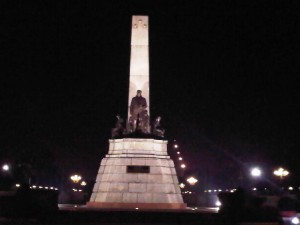Rizal statue now nat’l treasure

One hundred years after it was erected, the Rizal memorial statue (Rizal Monument) was declared a national cultural treasure on Monday by the National Museum of the Philippines. PHOTO BY RICK ALBERTO
One hundred years after it was erected, the Rizal memorial statue (Rizal Monument) was declared a national cultural treasure on Monday by the National Museum of the Philippines.
The National Museum defines a national cultural treasure as a unique cultural property found locally that possesses outstanding historical, cultural and artistic value considered highly significant to the country.
The bronze and granite Rizal Monument by Swiss sculptor Richard Kissling was originally called “Motto Stella,” or “Guiding Star,” and was unveiled on Dec. 30, 1913, during the 17th death anniversary of Dr. Jose Rizal. Its granite base contains the national hero’s remains.
In declaring the monument a national cultural treasure, the National Museum said it had become a “preeminent national, political, historical and cultural symbol, evoking the virtues, patriotism, sacrifice, death and legacy of Rizal.”
Leading exemplar
Article continues after this advertisementIt also described the structure as an artistic and cultural icon, and a leading exemplar for public monuments throughout the country and in Filipino communities around the world.
Article continues after this advertisementDuring Monday’s 117th celebration of Rizal’s martyrdom, the Order of the Knights of Rizal, headed by its supreme commander, Reghis Romero II, retraced the hero’s last footsteps from his prison cell in Fort Santiago to the plains of Bagumbayan (now Luneta Park) where he was shot.
Vice President Jejomar Binay and Manila Mayor Joseph Estrada, meanwhile, led the flag-raising and wreath-laying ceremony at the Rizal Monument to commemorate the hero’s martyrdom.
The historical marker declaring the Rizal Monument a national cultural treasure was built near the newly constructed 45-meter flagpole that drew criticism early this year because of its P8-million price tag.
The National Museum said it was committed to promoting, protecting and preserving the monument, which is considered a highly significant and intrinsic part of the cultural heritage of the country. The structure witnessed the independence of the Philippines from the United States and the establishment of the Republic of the Philippines on July 4, 1946.
Trademark overcoat
Rizal’s bronze sculpture stands on a pedestal in his trademark overcoat and gazing toward Manila Bay, a book in his left hand. An obelisk, topped with three gold stars, is the backdrop. Behind the statue, to the hero’s right, a mother is shown nursing her baby while to his left, two boys are reading.
Ninety nine meters away to the north of the monument are the grounds hallowed by the blood of patriots. It was there that the hero fell on his back, as if to welcome the blue sky that fateful morning on Dec. 30, 1896.
The monument was built as a memorial to Rizal, whom Filipinos hold in deep respect. Aware of this, the American colonizers sought to win Filipino sympathy by forming the US-Philippine Commission tasked to undertake and finance the Rizal Monument project through popular subscription.
The commission enlisted prominent Filipinos as members, including Paciano Rizal, the hero’s brother. The estimated amount for the monument was P100,000, with the insular government donating P30,000 to kick-start the fund-raising.
When the popular subscription finally closed in August 1912, the total collection had reached P135,195.61. The Filipinos themselves had funded the project.
Final design
From 1905 to 1907, the commission held an international competition to select the final design. On Jan. 8, 1908, the jury selected the winner out of 40 entries. It chose the “Al Martir de Bagumbayan” (“To the Martyr of Bagumbayan”) submitted by Carlo Nicoli of Italy. The “Motto Stella,” designed by Richard Kissling of Switzerland, came second.
But the “Al Martir de Bagumbayan” was never built. It was said that Nicoli failed to post the performance bond of P20,000, did not sign the contract on time and had a higher price quotation than Kissling. At any rate, the contract was finally awarded to Kissling.
The historic monument has stood on its present site for the last 100 years. Not only did it survive World War II but it also saved lives by shielding civilians during the fierce battle to liberate Manila from the Japanese in 1945.
And now, bathed in peace and bright lights, the hero and his remains enshrined in the monument are given honors by a four-man ceremonial guard from the Philippine Marine Corps 24 hours a day.
The monument is simple, solemn and dignified, and expresses the nation’s spirit at its best.—With Pablo S. Trillana III